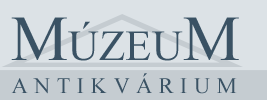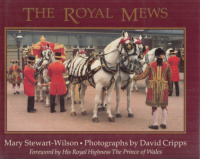kategóriák
- Közlekedés ajánlójegyzék
- Szocreál ajánlójegyzék
- Reklám ajánlójegyzék
- Fotó ajánlójegyzék
- Kínai-japán ajánlójegyzék
- Szentkép ajánlójegyzék
Új árakkal! - Új szentkép ajánlójegyzék II.
- 12 érdekes régiség
 Könyv
Könyv
 Bibliofilia
Bibliofilia
 Régiség
Régiség
 Metszet
Metszet
 Térkép
Térkép
 Fotó
Fotó
 Papírrégiség, Aprónyomtatvány
Papírrégiség, Aprónyomtatvány
 Plakát
Plakát
- Cirkusz
- Modern grafika
- Szocreál
- NER Irodalom
- Egyéb
kosár
üres a kosár
nincs bejelentkezve
Stewart-Wilson, Mary : The Royal Mews
- leírás
- további adatok
Photographs by David Cripps.
The spectacular Royal Mews behind Buckingham Palace is the department of the Royal Household responsible for the horse-drawn and motor travel arrangements of Her Majesty the Queen and members of the Royal Family. Its buildings form a hidden village of stables, workshops, homes, offices and garages, and the Mews community, despite modernisation, flourishes on customs and traditions that have been handed down over nine reigns. The Queen's regular use of horses and carriages has provided essential patronage for the skills of the craftsmen who also work there and are involved in their upkeep. The international media coveragt that is given to many domestic and ceremonial occasions throughout the Royal year means that Her Majesty's carriages and cars are very much in the public eye. But whether seen on the streets, the television screen or the printed page, there is little time for the spectator to absorb the wealth of historic detail that is on view in any royal procession. In their new book, Mary Stewart-Wilson and David Cripps present an unrivalled account of the carriages, horses, harness, livery and cars of the Royal Mews. What they have done is to stop the procession to allow a closer look at two and a half centuries of regal splendour and service to the Crown.
There are 21 chapters, six of which are devoted to a general view of the Mews. They survey the history of the building, current practices, the harness and horse trappings, livery, and the carriages, in general. Fourteen chapters deal with the carriages themselves, a chapter devoted to each one, or to each class of vehicle.
All the famous coaches are included: Queen Alexandra’s State Coach, King Edward VII’s Town Coach, The Scottish State Coach, The Ivory-Mounted Phaeton, The Balmoral Sociable, The 1902 State Landau, and the latest coach to be built, The Australian State Coach of 1988. Here also are the Ascot Landaus, the State and Semi-State Landaus, and the Barouches. The Gold Coach of 1762, stands in the forefront.
The chapter on The Irish State Coach is especially interesting for the entire restoration of that coach in 1988 is depicted and its construction details made evident for all to see. One cannot say enough in praise of the remarkable photographs of David Cripps. They exhibit a clarity and a brilliance unknown in the carriage photography world. Page after page springs alive with series after series of them. One need only examine the photographs of the harnesses, the door handles, the livery, the carvings and the heraldry to prove the excellence of this man’s work. As an historical record of the work carried out by the staff of The Royal Mews and a compliment to its efforts to maintain standards befitting the turnouts of Her Majesty, Queen Elizabeth II, this book is a fitting and unparalleled effort.
“What they have done is to stop the procession to allow a closer look at two and half centuries of regal splendor and service to the Crown.”
The spectacular Royal Mews behind Buckingham Palace is the department of the Royal Household responsible for the horse-drawn and motor travel arrangements of Her Majesty the Queen and members of the Royal Family. Its buildings form a hidden village of stables, workshops, homes, offices and garages, and the Mews community, despite modernisation, flourishes on customs and traditions that have been handed down over nine reigns. The Queen's regular use of horses and carriages has provided essential patronage for the skills of the craftsmen who also work there and are involved in their upkeep. The international media coveragt that is given to many domestic and ceremonial occasions throughout the Royal year means that Her Majesty's carriages and cars are very much in the public eye. But whether seen on the streets, the television screen or the printed page, there is little time for the spectator to absorb the wealth of historic detail that is on view in any royal procession. In their new book, Mary Stewart-Wilson and David Cripps present an unrivalled account of the carriages, horses, harness, livery and cars of the Royal Mews. What they have done is to stop the procession to allow a closer look at two and a half centuries of regal splendour and service to the Crown.
There are 21 chapters, six of which are devoted to a general view of the Mews. They survey the history of the building, current practices, the harness and horse trappings, livery, and the carriages, in general. Fourteen chapters deal with the carriages themselves, a chapter devoted to each one, or to each class of vehicle.
All the famous coaches are included: Queen Alexandra’s State Coach, King Edward VII’s Town Coach, The Scottish State Coach, The Ivory-Mounted Phaeton, The Balmoral Sociable, The 1902 State Landau, and the latest coach to be built, The Australian State Coach of 1988. Here also are the Ascot Landaus, the State and Semi-State Landaus, and the Barouches. The Gold Coach of 1762, stands in the forefront.
The chapter on The Irish State Coach is especially interesting for the entire restoration of that coach in 1988 is depicted and its construction details made evident for all to see. One cannot say enough in praise of the remarkable photographs of David Cripps. They exhibit a clarity and a brilliance unknown in the carriage photography world. Page after page springs alive with series after series of them. One need only examine the photographs of the harnesses, the door handles, the livery, the carvings and the heraldry to prove the excellence of this man’s work. As an historical record of the work carried out by the staff of The Royal Mews and a compliment to its efforts to maintain standards befitting the turnouts of Her Majesty, Queen Elizabeth II, this book is a fitting and unparalleled effort.
“What they have done is to stop the procession to allow a closer look at two and half centuries of regal splendor and service to the Crown.”
| állapot: |     |
| kategória: | Könyv > Idegennyelvű könyvek > Angol nyelvű > |
| kategória: | Könyv > Albumok > |
| kategória: | Könyv > Ló, lovaglás > |
| kiadó: | The Bodley Head. London, (1991) |
| cikkszám / ISBN: | 9780370313450 |
| kötés: | kötve/egészvászon (kiadói, eredeti védőborítóban) |
| oldalszám: | 192 |
| könyv nyelve: | angol |










 Telefon:
Telefon: E-mail:
E-mail:







